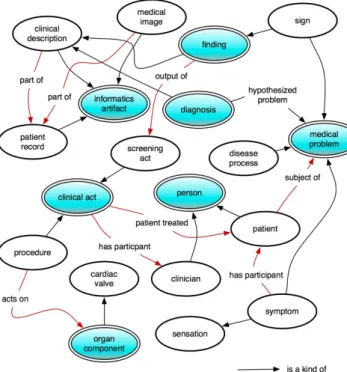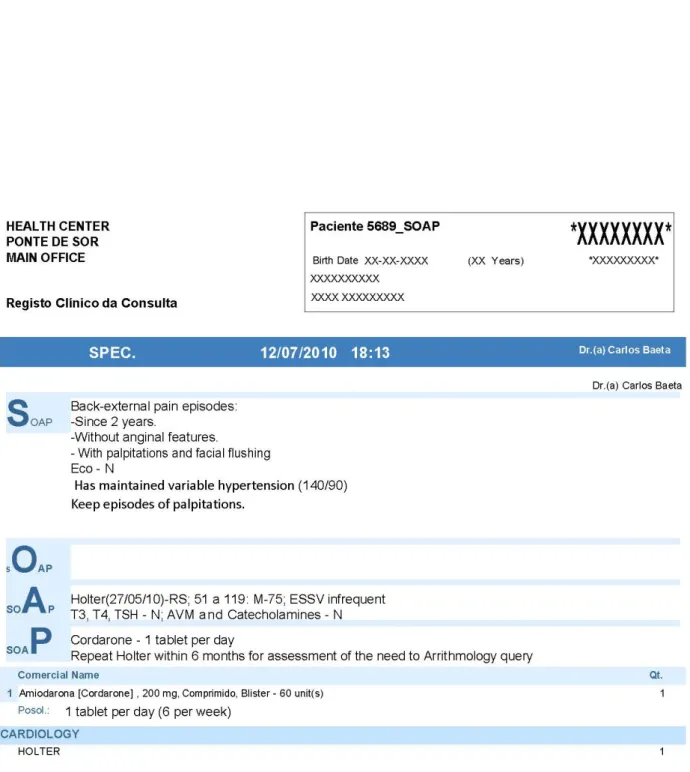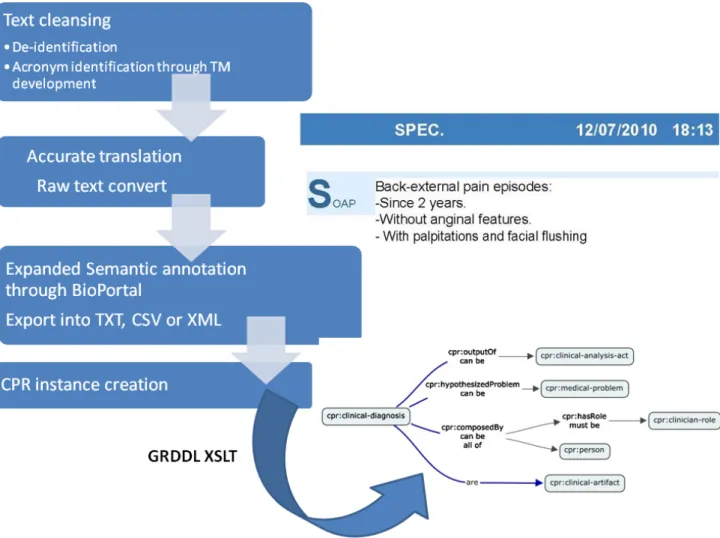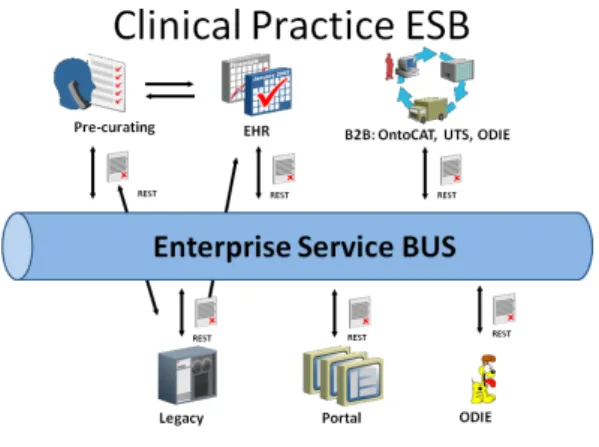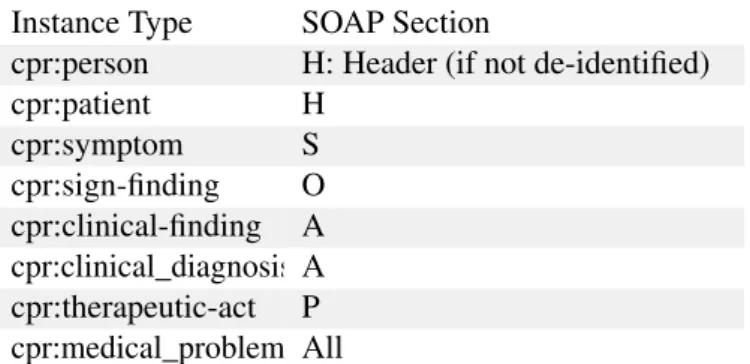www.eJHI.net
2012; Vol 7(x):eX
Advances to Semantic Interoperability
Through CPR Ontology Enrichment
Extracting from SOAP Framework Reports
David Mendes and Irene Pimenta Rodrigues
Universidade de Évora - Portugal
Abstract
We present the work done as a contribution to use an enriched ontology as the support for Semantic Interoperability among clinicians and systems in healthcare providing environments. Clinical practice ontologies are the next generation workhorse for automatic reasoning using Semantic Web techniques and tools in the healthcare sub-domain. Ontology instance acquisition from semi-structured data that renders a full picture of the general clinical practice is crucial for solid enrichment of an Ontology that is designed to embrace the generality of information located in EHR systems. These systems communicate syntactically using HL7 standardized messaging but must evolve to semantic interoper-ability based in a well formed standardized semantic where CPR acts as a Knowledge Representation infrastructure. Automated acquisition is absolutely a must given the enormous amounts of information available in the mentioned sources. Recent efforts directed to solve the overwhelming complexity of HL7 V3 CDA archetype, like the greenCDA template proposal, along with computability gained with OWL DL ontologies reasoning is leading to the possibility of development of foundations for strong Clinical Decision Support tools and Computable Semantic Interoperability representations in the Semantic Web. As an intermediate step to acquisition from standardized messaging we present the ontology population/enrichment taken from the widespread framework for communication that is the SOAP (Subjective, Objective, Assessment, Plan) clinical encounters documenting system.
Keywords: Computable Semantic Interoperability; CPR Ontology; Automatic Ontology Enrichment; SOAP Framework
1
Introduction
Several technologies related to the Semantic Web as well as scientific knowledge and standardization efforts have been developing very recently at an astonishing pace that lead us to consider that we have come of age of
5
gathering them all together and produce valuable contri-butions to the sub-domain of clinical practice automated reasoning. Most of the developments introduced have been maturing for years, or even decades, but finally in the last 2 years the convergence of the mentioned
10
fields are rendering availability of usable products that will allow artificial intelligence researchers and notice-ably natural language processing researchers [1] to build
upon.
2
Work done
15
We have been developing efforts to extract clinical in-formation from texts in Portuguese in order to represent them in computable forms able to reason about using Se-mantic Web tools and techniques [2]. Previously there was work done in proper selection of an adequate form
20
Knowledge Representation (KR) suitable for the task of supporting the possibility of automated reasoning about clinical practice [3]. Meanwhile, we presented our proposal of ontology population from HL7 V2.xml messaging not yet specifying the target ontologies but
25
mainly reviewing and focusing on the acquisition1 pro-cess [4].
3
Experimental results
In the Portalegre district in Portugal the Unidade Local de Saúde do Norte Alentejano (ULSNA), E.P.E. (2) has
30
in its objectives the provision of primary and secondary health care to the population. ULSNA is a health-care providing regional system that includes 2 hospitals (José Maria Grande in Portalegre and Santa Luzia in Elvas) and the primary care centers in all the district counties.
35
A group of clinicians chosen by our trial investigator Dr. Carlos Baeta provided us some dozens of clinical reports de-identified according to safe-harbor princi-ples, as reviewed in [9], from the SAM system in use both in the Primary Healthcare units and in the
Hos-40
pitals. These clinicians are mainly cardiologists from the hospitals but also general medicine (primary care) physicians that normally use reports like those provided to communicate between them. Using the clinical data that is available for us we intend to take advantage of
45
the tooling presented here to reach the objectives pre-sented in the Introduction section. The adequacy of the method and tools proposed here, however, are to be evaluated by the clinicians themselves. We are cur-rently in the process of assessing the manual processes
50
with a selected group of clinicians both from primary and secondary care that will after developing their own TMs, at their own pace, integrate them in the complete ontology acquisition workflow to be able to assess the reasoning capabilities that can be made available. We
55
are developing a process of quality assessment that will be presented as soon as available and processed, ex-pected during 2012. After this controlled group we intend that the generated TMs are included in a corpus that will ease extremely the adherence of the rest of the
60
community and try to expand to regional level which shall then be a straightforward step to achieve.
4
CPR in 2011 as adequate KR
for Clinical Decision Support and
other automated reasoning
en-65
deavours
When developing our previous work [3] we faced sev-eral options in choosing an adequate Ontology and we chose Computer-based Patient Record Ontology (CPR)
1
In the present paper the term “acquisition” is always referring to clinical terms for ontology instance creation
2
http://www.ulsna.min-saude.pt/
[5] standardized by the World Wide Web Consortium
70
(W3C) in 2009 by reasons that we now explain briefly here for self containment of the present article.
4.1 Theoretical Considerations
The medical practice sub-domain we want to represent is a many faceted science that renders complexities with
75
difficult issues to be addressed such as Temporality, Location, Granularity, High ambiguity in free text ter-minology, Jargon plagued with acronyms and even per-sonal nicknames for example. We have to abide to solid design foundations for proper Ontology alignment and
80
interoperability. Well formed ontologies are able to sup-port a variety of secondary uses not anticipated when the ontology was originally conceived [6] and we may have to pick among available ontologies that have is-sues of overlapping, ambiguity, non-completeness and
85
more. Trying to figure out the availability of such an ontology suitable for our purposes, we tried to find an available standard ontology according to the Ontol-ogy Realism principles enunciated in [7] and with the freedom to be extendable according to anyone’s
par-90
ticular needs. The ontologies shall be in accordance to the OBO Foundry principles. We just try to bring together the latest Software Engineering principles to the Ontology Engineering field. With the loose cou-pling availability and configurable service intermixing,
95
we picked what we could spot has low-hanging fruit to develop our systems rendering them sub-optimal but demonstrable of the validity of the concepts and easily extendable/tunable with better ontology support, finer Web Service provisioning but most of all with better
100
clinical judgement about the “smart choices” that have to be taken to better populate the ontology given the scarce source structure of the original clinical episodes texts as seen in section 5.
4.2 Classes to populate
105
We try to follow the CPR archetypes depicted in Fig-ure 1 as close as possible when acquiring from free-text. However, some of the more complex classes like cpr:medical_problem are fairly hard to formulate and we have to admit that the gleaning presented in the
110
present work renders a rather simplistic representation. The formalization of a medical practice theory however, the purpose of the CPR ontology, renders the possibil-ity of important automated reasoning from the simple acquisition that we are proposing.
115
A much more systematic representation has to be used as source of information for the rendered ontolo-gies to approach more the reality of clinical practice
Figure 1: CPR Patient Record Archetypes
for a given clinician, medical device, service, specialty, healthcare providing institution or system. Some
pro-120
posals that can contribute to this enhancement of our work are presented ahead in the Future Work section.
5
Automated acquisition from
Clini-cal Episodes Text
As reviewed in [4] the state-of-the-art for acquisition
125
from clinical text has enjoyed strong developments in recent years. In the mentioned paper we present a pro-posal for automated acquisition from HL7 messaging but here we are delving into the more generic possibility of extracting from free text present in most reporting
sys-130
tems used by clinicians. Going from clinical episodes text that is usually presented in a human friendly for-mat to one adequate for computer processing involves a fair amount of text processing to handle different situa-tions because: (1) Reports aggregate information from
135
different clinical episodes that are not uniquely identi-fied or not even individually dated, (2) the clinician is only identified by his/her name if any identification is made at all, (3) the information conveyed in free text is intended only to be understandable by fellow
practi-140
tioners or even by the clinician him/herself making use of pragmatic jargon normally plagued with acronyms and nicknames abundant in their specific community, (4) text is profoundly intermixed with decorative ele-ments for better legibility, normally in PDF or HTML
145
files, (5) the clinicians natural language may be other
than English without concepts defined in a foundational thesaurus like SNOMED CT or FMA for instance that don’t exist in their particular language and finally, (6) the time spanning and snapping of the processes
de-150
picted in natural language is often difficult to extract and represent formally. We intend to collect our infor-mation from SOAP reports like the de-identified sample in Figure 2.
5.1 SOAP PDF Processing
155
We take advantage of the fact that the report depicts a clinical encounter in a semi-structured way to ma-nipulate into a more tractable source. The Subjective, Objective, Assessment, Plan (SOAP) framework, used to structure progress notes to facilitate problem specific,
160
clinical decision making by physicians, is a well known, canonical structure in the medical domain. The under-lying structure of the SOAP report induces some very important assumptions to be true. We find sections that can be associated with Subjective, the symptoms
sec-165
tion S where we extract directly into a cpr:symptom record, medications found here are those administered only during the patient visit; Objective, the objective section O that are sign records cpr:sign-finding that we take as generator for cpr:clinical_finding in the
170
Assessment section; Assessment, the analysis section A which are the clinical investigation acts whose out-puts can be clinical artifacts to investigate things that can be consequence of any of physiological or patho-logical processes, and finally, Plan, the plan section P
175
where the cpr:therapeutic-act can be extracted with all the timing, posology and prescriptions registered in that particular clinical encounter, medications here are prescribed for discharge [8]. Aggregating the in-stances collected so far we finally engage in the more
180
complex cpr:medical_problem development. We now take advantage of the fact that we have to translate from jargon to English to customize our centralized TMM (Translation Memory Managers) like the Google trans-lator toolkit3or mymemory translation services4 en-185
hanced with our own Translation Memories and Glos-saries. We use the architecture presented ahead in sec-tion “The full Software architecture picture” to do all the juggling involved in workflow processing of our source documents. We start from a PDF document,
ex-190
port to XML, de-identify according to determined legal ruling (like HIPAA Safe-harbor) [9], refine the clinical jargon using automated translations with the aid of CAT (Computer Aided Translation) software with previously trained Translation Memories in TMX standardized
for-195 3
https://translate.google.com/toolkit/
4
mat and then finally convert into raw text to proceed to Semantic Annotation. The pre-processing workflow may be roughly depicted in Figure 3.
5.2 The adequate annotation workflow
A set of sequential steps must be used to go from the
200
pure text to the extracted concept instance. Those steps workflow can be configured declaratively using the soft-ware architecture shown in the specific architecture sec-tion. The translation steps involved are: (1) Manual translation (that is indispensable for the translator
tu-205
toring) with the precise clinicians validation of their jargon adequately translated into English, (2) PDF to raw text, or to structured (XML), converting for ad-equate documents cleansing. The remote annotation steps are: (3) NER (Named Entity Recognition) of all
210
the patient names, clinician names, addresses, symp-toms, signs and prescriptions with all the acronyms, units, time-spanning and time-snapping involved with the usual short forms that a particular doctor usually uses. In our particular situation we maintain a local
215
cache of the previously identified vocabulary to check exact concept matching, (4) WSD (Word Sense Disam-biguation) where terms can be disambiguated without technical clinical expertise. Most of them however have to be disambiguated according to the previously
ac-220
quired concepts in our controlled vocabulary, (5) EAV (Extraction of Attributes and Values) is the final pure, single language, task that has to be performed and in which we need the tooling that this paper refers to filter the concepts from the annotated text to extract concept
225
instances, (6) Semantic annotation using the interface of BioPortal, either manually using the interactive inter-faces or automatically with the Web Services available. Given the array of Web Services that can semantically annotate bio-medical concepts in English, we chose to
230
use an evolutionary approach for use of the BioPortal annotator. We first use the annotator Web Interface after manual preprocessing for the TM tutoring and later a fully automatic workflow based in Web Services orches-tration.
235
6
Ontology driven annotation
The annotation step is done using annotation provided by semantically aware REST annotators in BioPortal5. This service renders a two step annotation process that builds upon user-selected ontologies to perform the
sec-240
ond step of semantic annotation expansion by trying to
5
http://bioportal.bioontology.org
correlate the term identified in the first step among the selected biomedical ontologies:
The Semantically Expanded Annotations are then returned by the REST Web Service in TXT, CSV or
245
XML. With this latest option we can proceed to extract into a CPR instance. To define what elements of the returned XML are suitable for CPR instances we further enhance the XML with GRDDL entries specifying the appropriate XSLT transform to apply (2 XML lines).
250
Unfortunately the announced web service provision-ing of annotations in OWL format is not yet available from BioPortal but we have the proposed structure and that gives us the ability of developing the transforms for OWL converting as soon as that format becomes
255
available.
7
Restricting to Clinical Practice
us-ing only SNOMED CORE
One important and pragmatic restriction that we im-pose is in the use of SNOMED CORE to restrain the
260
terminology mapping. Instead of using the BioPortal SNOMED CT that would render us the choice among more than 311,000 concepts we intend to explore only a consolidated view of clinical practice terms and we now have the possibility to use only SNOMED CORE that
265
turns our solution much more manageable while not loosing relevant terminology. Available since July 2009, the CORE (Clinical Observations Recording and Encod-ing) Problem List Subset of SNOMED CT was derived based on data-sets submitted by seven large scale
health-270
care institutions. The purpose of the CORE Project is to define a Unified Medical Language System subset that is most useful for documentation and encoding of clini-cal information at a summary level, such as problem list, discharge diagnosis or reasons of encounters. The most
275
frequently used terms (covering 95% of usage volume) from these institutions are mapped to the corresponding SNOMED CT concepts where such concepts exist. The Subset contains about 5,000 SNOMED CT concepts and this downsizing permits the reasoners to classify
280
much more effectively the resulting annotations. This important constraint that we are imposing is a practical solution based in what views are currently available but does not take into proper account recent research that is evolving regarding issues in automated
285
extraction like modularization and segmentation as in-troduced in [10].
Figure 3: SOAP text processing workflow
Figure 5: CP-ESB Architecture
7.1 Automatic transform generation
Based in the availability of CPR class archetypes and the XML structured responses from the REST Web Services
290
we developed XSLT mappings that are invoked through the use of GRDDL mechanism. In the case of XSLT we just use plain XML processing but we can even use some Java based framework that has the ability to process Ontologies and GRDDL like Jena6to integrate
295
in the Java Enterprise Edition based system presented in the next section.
7.2 The full software architecture picture
As presented in [11] we build our proposal based in a lightweight messaging bus that we call Clinical
Prac-300
tice – Enterprise Service Bus (CP-ESB). This RESTful based hub is responsible for orchestrating all the com-munications between Web Service invocations allowing a high degree of customization and plug-and-play abil-ity that renders our proposal very flexible and future
305
proof:
Reviewing the above referred points from SOAP we can now summarize in the following table the complete acquisition points that fit in the timeline for clinical process acquisition proposed by Scheuermann et al in
310
2009 [12]. Each identified point generates a gleaning entry in soap_to_cpr.xslt transform file summarized in Table 1.
As explained in the “Classes to populate” section we can only collect a thin representation when using our
315
SOAP approach but the application of this methodology by the enormous number of clinicians that use this glob-ally widespread framework delivers interesting results like the mere inferencing of the actual relations between
6
http://jena.sourceforge.net/index.html
collected instances from S,O,A and the consequences
320
described in P.
8
Path to facilitate CSI
CSI is not dependent of any particular implementation, data structure or archetype in any of the different points that have to share the knowledge. What is important is
325
a shareable meaning foundation that has to be agreed by all. We have previously argued [14] that an important contribution is brought by BRIDG7. The Biomedical Re-search Integrated Domain Group (BRIDG) Model is a collaborative effort engaging stakeholders from the
Clin-330
ical Data Interchange Standards Consortium (CDISC), the HL7 Regulated Clinical Research Information Man-agement Technical Committee (RCRIM TC), the Na-tional Cancer Institute (NCI) and its Cancer Biomedi-cal Informatics Grid (caBIG ), and the US Food andR 335
Drug Administration (FDA). The BRIDG model is an instance of a Domain Analysis Model (DAM). The goal of the BRIDG Model is to produce a shared view of the dynamic and static semantics for the domain of protocol-driven research and its associated regulatory artefacts.
340
In the mentioned paper we sustain that inn Healthcare, every system involved must agree in the meaning of a clinical concept. This is the fundamental concept of Shared Semantics that has to be realized to obtain CSI in the Health sub-domain of knowledge. We present
345
the HL7 RIM inadequacy for ontology mapping and how to circumvent it using the BRIDG DAM. This ap-proach will serve as guideline to alleviate the evident differences between CPR structure and the underlying models structure like the RIM or SOAP. Several options
350
that are taken pursue the DAM.
9
Future work
In 2007 the work done under the W3C - Semantic Web Healthcare and Life Sciences Interest Group auspices8 rendered amazing contributions done with the most
in-355
teresting technological landscape available at the time. Some realities that have since evolved and we could use for the present work are:
(a) The Problem-Oriented Medical Record Ontology that was started to be developed in 2006 was the
360
target of the fruitful GRDDL efforts that appeared during 2007 in which base we are now working on. This efforts however were rdfs based for the OWL developments were still incipient. Only in
7
http://www.bridgmodel.org/
8
Instance Type SOAP Section
cpr:person H: Header (if not de-identified) cpr:patient H cpr:symptom S cpr:sign-finding O cpr:clinical-finding A cpr:clinical_diagnosis A cpr:therapeutic-act P cpr:medical_problem All
Table 1: XSLT transforms for XML OBA Annotation to CPR instance
November 2009 W3C standardized a OWL based
365
ontology called the CPR that we use in our work. (b) For a given HL7 Clinical Document
Architec-ture (CDA) document the GRDDL gleaning pre-sented in 2007 with it associate transform9creates
one cpr v0.5 instance with one cpr:patient.record
370
with as many cpr:screening-acts and associated cpr:clinical-descriptions as episodes are referred in the CDA source. This approach, though impres-sive technology, lacks the granularity that can be rendered now with further developments that CPR
375
has gained in its latest versions.
Taking advantage of the developments done so far we intend to build upon what was then achieved and propose work to be developed like:
9.1 Extend our proposal to use GRDDL for
380
gleaning HL7 documents into CPR
The same architecture that we are proposing for glean-ing from BioPortal’s Open Biomedical Annotator (OBA) output may be, as well, used to extract resources from CDA documents compliant with RIM V3.
How-385
ever it seems obvious that the complexity that the spec-ification conforms could easily “hinder the trees and not show the forest”. Many recent proposals are being developed to apply restricted templates to make RIM tractable. The most notorious, that we intend to make
390
reference to here, is the greenCDA10project that already has delivered results. In fact, the greenCDA specifica-tion has been officially balloted via HL7 and the version 1.0 is already available for download11.
9 http://www.w3.org/2001/sw/grddl-wg/td/hl7-rim-to-pomr. xslt 10http://wiki.hl7.org/index.php?title=GreenCDA_Project 11 http://www.hl7.org/documentcenter/ballots/2010SEP/ downloads/CDAR2_IG_GREENMOD4CCD_R1_I1_2010SEP. zip
9.2 Using only refined templates of HL7 V3 like
395
greenCDA instead of the full CDA
The idea was that the CDA was capable of represent-ing any aspect of the medical record for any purpose. That sounds like a noble idea but in practice it cre-ates a fixed overhead for even the simplest data
ex-400
change. The greenCDA project has developed a prag-matic methodology for creating simplified schemas that can be transformed directly to or from normative CDA. The initiative can be briefly described as a simple to use, XML construct that incorporates structured and
unstruc-405
tured clinical summary information. Simpler than CDA but full featured. There are tools available to convert CDA into Green CDA and also additional tools are be-ing developed to enable easy creation of Green CDA constructs by navigating the RIM, selecting attributes,
410
and selecting associations to consolidate to make the XML flatter. We feel that the development of XSLT for GRDDL processing from greenCDA documents is a very viable process of rendering a quasi complete picture of clinical practice extracting from HL7
mes-415
saging. We already have available the XML-Schema and transforms for back and forth CDA conversion and very easily will develop the OBA annotator output of greenCDA documents to CPR GRDDL transforms.
9.3 Restrict CPR to be OWL DL well formed or
420
even further
Unfortunately, CPR is not currently OWL DL syntax conformant. For the current reasoners to work effec-tively with OWL based ontologies they have to be OWL DL to be validatable in linear time. Al-though our
clini-425
cal practice ontologies are restricted in their size most of the times, the reasoners check the validity a-priori and tend to refuse to work when some non-conformities are found. One interesting line of research may be the adequate restriction of CPR to be OWL DL conformant
430
without lost of the needed expressiveness for clinical practice representation. We found even arguable that
with adequate restrictions, like elimination of transi-tivity [13] a Horn SHIQ ontology can be developed from CPR and then we reach the possibility of applying
435
Consequence-Driven Reasoners that have been shown recently to be very attractive for dealing with huge data-sets.
10
Conclusion
We presented our proposal for using the enriched CPR
440
ontology, automating the acquisition with resource to SOAP framework reports, as support for Computable Semantic Interoperability. Being a framework directed to human interpretation it lacks the completeness that can be achieved with more formal ways of representing
445
clinical encounters directed to computer consumption like the various standardized protocols and archetypes developed for computer to computer interaction through messaging like ISO HL7 27931:2009 or the Archetypes in HL7 V3 RIM. We demonstrated the workflow to
450
evolve from a raw SOAP report in natural language to a CPR instance creation both manually and automatically through the use of the available Web Services that “on-tology driven” annotate with resource of “feeder ontolo-gies” that we criteriously select. Our final architecture
455
has the possibility to automatically process the source documents into the ontology through the suggested soft-ware components that is easily expanded/refined to in-corporate new sources of clinical information, enhanced ways of annotation and different target ontologies in a
460
plug-and-play manner.
References
1. Demner-Fushman D, Chapman WW, McDonald CJ,. What can natural language processing do for clinical decision support?. Journal of Biomedical
465
Informatics 42 (5), Biomedical Natural Language Processing. 2009; pp. 760-772.
2. Mendes D, Rodrigues IP. Automatic Ontology Pop-ulation extracted from SAM Healthcare Texts in Portuguese. In: Jornadas de Informática da
Univer-470
sidade de Évora 2011. ISBN: 978-989-97060-2-6, URL http://host.di.uevora.pt/docs/actas-jiue2011. pdf
3. Mendes D, Rodrigues IP. Well Formed Clinical Practice Ontology Selection. In: Jornadas de
In-475
formática da Universidade de Évora 2011. ISBN: 978-989-97060-2-6, URL: http://host.di.uevora.pt/ docs/actas-jiue2011.pdf
4. Mendes D, Rodrigues IP. A Semantic Web prag-matic approach to develop Clinical ontologies,
480
and thus Semantic Interoperability, based in HL7 v2.xml messaging. In: HCist 2011 - Proceed-ings of the International Workshop on Health and Social Care Information Systems and Technolo-gies. Springer-Verlag - book of the CCIS series
485
(Communications in Computer and Information Science).
5. W3C, 2009. Computer-based Patient Record Ontology URL http://code.google.com/p/ cprontology.
490
6. Smith B, Scheuermann RH. Ontologies for clinical and translational research: Introduction. Journal of biomedical informatics 44. 2011; 3-7. URL http://www.ncbi.nlm.nih.gov/pubmed/21241822. 7. Smith B, Ceusters W. Ontological realism: A
495
methodology for coordinated evolution of scien-tific ontologies. Applied ontology 5 (3-4), 2010; pp. 139-188.
8. Mowery D, Wiebe J, Visweswaran S, Harkema H, Chapman WW. Building an automated soap
classi-500
fier for emergency department reports. Journal of Biomedical Informatics. 2011.
9. Meystre S, Friedlin M, South FJ, Shen BR, Samore S. Automatic de-identification of textual docu-ments in the electronic health record: a review
505
of recent research. BMC medical research method-ology. 2010; pp. 10-70.
10. Ogbuji C, Arabandi S, Zhang S, Zhang GQ. Seg-menting and Merging Domain-specific Ontology Modules for Clinical Informatics. In: Galton A,
510
Mizoguchi R (Eds.), Frontiers in Artificial Intelli-gence and Applications: Formal Ontology in Infor-mation Systems - Proceedings of the Sixth Interna-tional Conference (FOIS 2010); pp. 414-428. 11. Mendes D, Rodrigues IP.. Clinical Practice
On-515
tology Development Best Practices. Journal of Biomedical Informatics. 2012; To be published. 12. Scheuermann RH, Ceusters W, Smith B. Toward an
Ontological Treatment of Disease and Diagnosis. AMIA Summit on Translational Bioinformatics.
520
San Francisco, CA. 2009; pp. 116-120.
13. Kazakov Y. Consequence-driven reasoning for Horn SHIQ ontologies. IJCAI. 2009; pp. 2040–2045.
14. Mendes, D. & Rodrigues, I.P. The BRIDG model
525
as the most authoritative resource in Shared Se-mantics for Ontologies development in Healthcare practice. In Proceedings of the International Con-ference on Knowledge Management and Informa-tion Sharing. pp. 1-9. 530
